动词的ing-形式做主语和宾语
V-ing作主语、宾语
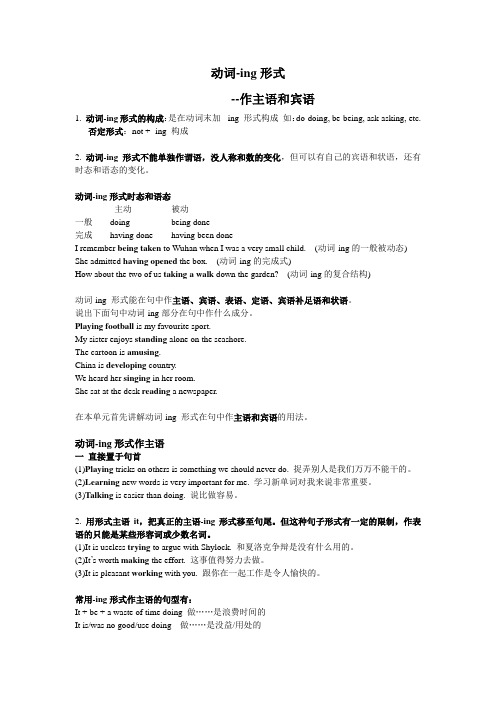
动词-ing形式--作主语和宾语1. 动词-ing形式的构成:是在动词末加-ing 形式构成如:do-doing, be-being, ask-asking, etc.否定形式:not + -ing 构成2. 动词-ing形式不能单独作谓语,没人称和数的变化,但可以有自己的宾语和状语,还有时态和语态的变化。
动词-ing形式时态和语态主动被动一般doing being done完成having done having been doneI remember being taken to Wuhan when I was a very small child. (动词-ing的一般被动态) She admitted having opened the box. (动词-ing的完成式)How about the two of us taking a walk down the garden? (动词-ing的复合结构)动词-ing 形式能在句中作主语、宾语、表语、定语、宾语补足语和状语。
说出下面句中动词-ing部分在句中作什么成分。
Playing football is my favourite sport.My sister enjoys standing alone on the seashore.The cartoon is amusing.China is developing country.We heard her singing in her room.She sat at the desk reading a newspaper.在本单元首先讲解动词-ing 形式在句中作主语和宾语的用法。
动词-ing形式作主语一直接置于句首(1)Playing tricks on others is something we should never do. 捉弄别人是我们万万不能干的。
(2)Learning new words is very important for me. 学习新单词对我来说非常重要。
动词-ing形式作主语和宾语

一、动词-ing形式作主语和宾语考点一:动词-ing形式的基本用法动词-ing具有名词的性质,可在句中担当主语、宾语、标语、定语、宾语补足语和状语,动词-ing形式作主语常用来表示经常性和习惯性的动作。
动词-ing形式作主语通常放在句首。
但不能单独做谓语。
考点二:动词-ing做主语的用法:1)动词-ing作主语时,往往表示习惯性、经常性的动作,在口语中也表示具体的动作。
如:Paiting is his hobby.2)动词-ing形式作主语和不定式作主语一样,也可以用it做形式主语,但不定式作主语往往表示具体的特别是将来的动作。
如:It is no use talking without doing.光说不做是没用的It is so hot. what I want to do now is to have a swim in a river.天这么热,现在我想做的事情就是在河里游泳。
动词-ing形式作主语时,为了保持句子平衡,可以用it作形式主语。
常用的结构:1. It is + no use / no good / useless etc.+ v-ing2. It is + nice / good / interesting / a waste of…etc. + v-ing例如:It is no use crying over spilt milk.事考点三:动词-ing形式作宾语的用法1.有些动词或动词短语常用动词-ing形式作宾语:admit,avoid,appreciate,consider,enjoy,escape,finish,keep,mind, miss, suggest等动词; can’t stand, give up, feel like, keepon, think of, set about, dream of等短语。
避免错过少延期建议完成多练习喜欢想象禁不住承认否定与嫉妒逃避冒险xxxx忍受保持不介意考虑欣赏还愿意2.在下列短语中,to是介词,后面应用动词-ing形式作宾语:be / get us ed to, look forward to, devote…to, pay attention to,object to等。
语法复习动词ing形式作主语和宾语课件

详细描述
列出多个句子,其中一些句子含有动词-ing形式作主语或宾语,一些句子则没有,让学 生从中选择正确的句子。
段落写作练习
总结词
提升应用能力
VS
详细描述
布置一个主题或情境,要求学生使用动词 -ing形式作主语和宾语进行段落写作,以 锻炼他们的语言组织和应用能力。
感谢您的观看
THANKS
定义
动词-ing形式作宾语是指动词以ing形式作为句中的宾语成分,常 出现在句子的谓语动词之后。
特点
动词-ing形式作宾语具有进行时 态的特点,表示动作正在进行或 持续发生。
常见句型结构
主语 + 谓语 + 动词ing形式作宾语
主语 + 谓语 + 间接 宾语/直接宾语(动 词-ing形式)
主语 + 系动词 + 表 语(动词-ing形式)
语法复习动词ing形 式作主语和宾语课件
目录
CONTENTS
• 动词-ing形式作主语 • 动词-ing形式作宾语 • 动词-ing形式作主语和宾语的用法 • 动词-ing形式作主语和宾语的注意事项 • 动词-ing形式作主语和宾语的练习与巩
固
01 动词-ing形式作主语
定义与特点
定义
动词-ing形式作主语指的是在英语句子中,使用动词的-ing 形式作为句子的主语,表示该动作或行为是句子所描述的对 象。
特点
动词-ing形式作主语具有描述性、动态性和进行性的特点, 能够生动地描述某个动作或行为的正在进行状态,强调该动 作或行为的持续性、过程性和特征。
常见句型结构
“It + be + -ing + that从句”结构
动词ing的用法

keep on take up feel like
1.Isn't it time you got down to______ the papers? (2006重庆卷) A.mark B.be marked C.being marked D.marking 2. You can't imagine what difficulty we had ______ home in the snowstorm. (2007辽宁卷) A. walked B. walk C. to walk D. walking 3. —Can I smoke here? —Sorry. We don’t allow ______ here. (2007江苏卷) A. people smoking B. people smoke C. to smoke D. smoking 4.I can’t stand _____ with Jane in the same office. She just refuses______ talking while she works. (2006北京卷) A. working ; stopping B. to work ; stopping C. working ; to stop D. to work ; to stop 5. Having been ill in bed for nearly a month, he had a hard time ______ the exam. (福建2004) A. pass B. to pass C. passed D.passing
一、动词-ing形式作主语 (动名词)
① Teaching is my full-time job. ② Writing an English composition is not easy. [考点1] 动词-ing形式作主语表示 抽象或泛指动作
高中英语知识导学 动词--ing形式作主语和宾语
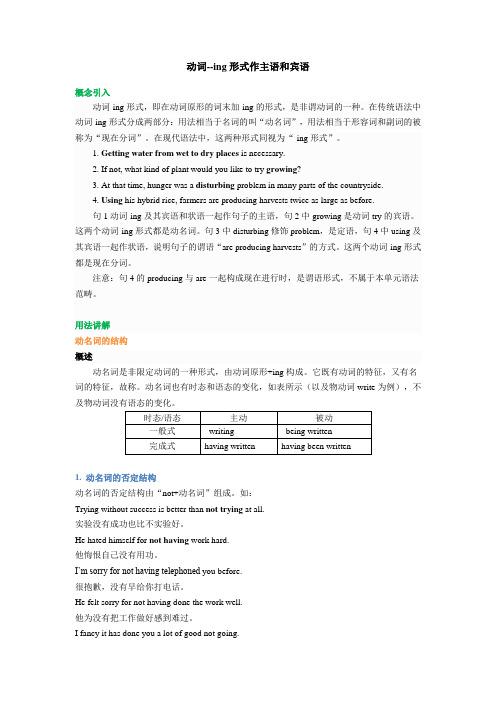
动词--ing形式作主语和宾语概念引入动词-ing形式,即在动词原形的词末加-ing的形式,是非谓动词的一种。
在传统语法中动词-ing形式分成两部分:用法相当于名词的叫“动名词”,用法相当于形容词和副词的被称为“现在分词”。
在现代语法中,这两种形式同视为“-ing形式”。
1. Getting water from wet to dry places is necessary.2. If not, what kind of plant would you like to try growing?3. At that time, hunger was a disturbing problem in many parts of the countryside.4. Using his hybrid rice, farmers are producing harvests twice as large as before.句1动词-ing及其宾语和状语一起作句子的主语,句2中growing是动词try的宾语。
这两个动词-ing形式都是动名词。
句3中disturbing修饰problem,是定语,句4中using及其宾语一起作状语,说明句子的谓语“are producing harvests”的方式。
这两个动词-ing形式都是现在分词。
注意:句4的producing与are一起构成现在进行时,是谓语形式,不属于本单元语法范畴。
用法讲解动名词的结构概述动名词是非限定动词的一种形式,由动词原形+ing构成。
它既有动词的特征,又有名词的特征,故称。
动名词也有时态和语态的变化,如表所示(以及物动词write为例),不及物动词没有语态的变化。
1. 动名词的否定结构动名词的否定结构由“not+动名词”组成。
如:Trying without success is better than not trying at all.实验没有成功也比不实验好。
动词ing形式作主语和宾语

❖ Can you imagine him/Jack cooking at home? ❖ 你能想象他/杰克在家做饭的样子吗?
[名师点津] (1)动词-ing 形式的复合结构可在句中作主语或宾语。作主语时, 不能用③④两种形式。 (2)无生命名词无论是作主语还是作宾语都不能用第②种形式。 Tom's winning the first prize last year impressed me a lot. 汤姆去年得了一等奖使我印象深刻。 Do you mind my/me/Jack’s/Jack leaving now? 你介意我/杰克现在离开吗?
❖ [思维导图]
❖ 一、概念
❖ 动词ing形式是动词的一种非谓语形式,包 括现在分词和动名词两种。
❖ 1.动词ing形式的时态和语态
时态
语态 主动语态
被动语态
一般式
doing
being done
完成式
having done having been done
❖2.动词ing形式在句中的语法作用
❖ 动名词在句中作主语、宾语、表语和定 语;现在分词在句中作状语、宾语补足语和 定语。
I forgot posting the letter. 我忘了信已寄出。
❖ 四、动词ing形式的否定形式 ❖ 动词ing形式的否定形式通常是在其前加
not,带有逻辑主语时not应放在逻辑主语和 动词ing形式之间。
❖ You have no excuse for not going. ❖ 你没有理由不去。
❖ 4.在begin,start,continue,intend后用动 词ing形式和用不定式作宾语均可,意义没 有多大区别。
动词-ing形式做主语和宾语
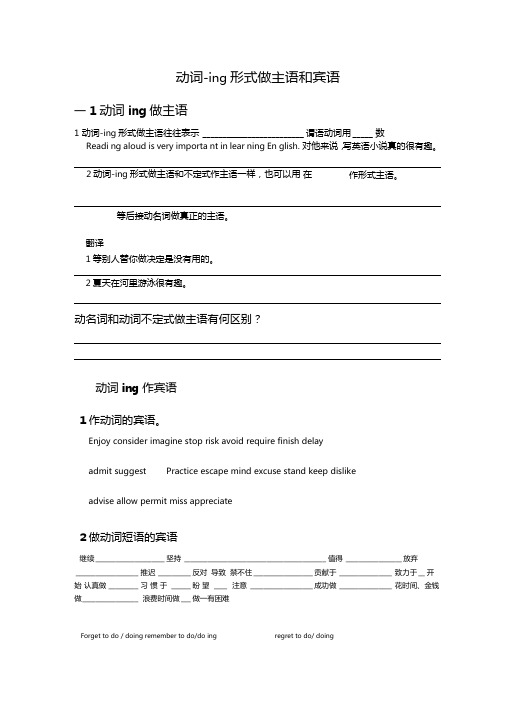
动词-ing形式做主语和宾语一1动词ing做主语1 动词-ing形式做主语往往表示_________________________ 谓语动词用 _____ 数Readi ng aloud is very importa nt in lear ning En glish. 对他来说,写英语小说真的很有趣。
动词ing作宾语1作动词的宾语。
Enjoy consider imagine stop risk avoid require finish delayadmit suggest Practice escape mind excuse stand keep dislikeadvise allow permit miss appreciate2做动词短语的宾语继续_____________________ 坚持___________________________________________ 值得_________________ 放弃___________________ 推迟__________ 反对导致禁不住 __________________ 贡献于________________ 致力于__ 开始认真做 _________ 习惯于 ______ 盼望 ____ 注意___________________ 成功做 ________________ 花时间、金钱做_________________ 浪费时间做 ___ 做一有困难Forget to do / doing remember to do/do ing regret to do/ doing3写出汉意Forget to do / doing remember to do/do ing regret to do/ doingStop to do /doing4 n eed/require/ want doing/to be done翻译窗户需要擦了。
动词-ing

动名词的形式
主动形式
一般式 doing having done
被动形式
being done having been done
完成式
1.动名词一般式doing表示的动作通常是一般性动 作,即不是明确地发生在过去、现在或将来的动 作,或是与谓语动词所表示的动作同时发生的动 作。 例:Students sitting in this classroom are having an English contest.(主动,同时发生) The man planting trees in front of the building is our PE teacher.(主动,进行)
2.有些动词后既可跟 动名词 也可跟 不定式,意义 上没多大区别。如:like, dislike, love, prefer, start, begin, continue 等。 例: I don’t like watching TV.(指一般性行为) I like to play basketball tomorrow. (指一次的动作) 3.need,want,require,deserve+doing/to be done 主动形式表达被动意义。 例:The car needs repairing/to be repaired. 4.permit,allow,advise,forbid doing sth. sb. to do sth. 例:She doesn’t allow talking here. us to talk here.
例:He kept me waiting for an hour in the rain.
六、做状语
可充当时间、原因、条件、伴随、结果或让步 状语。逻辑主语为句子的主语,表主动,或者 进行。 例:When hearing the good news,the students were wild with joy.(时间状语) There being nothing to do, she went home.(原因状语)
动词-ing形式(短语)作主语和宾语

动词-ing形式(短语)作主语和宾语一、动词-ing形式(短语)作主语1. 动词-ing形式(短语)作主语,表示比较抽象或泛指的动作。
如:Telling a lie got him into a great deal of trouble.Surfing is a popular sport along coastal areas.2. 动词-ing形式(短语)作主语时,为了保持句子平衡,可以用it 作形式主语。
如:It is no use complaining —it doesn’t he lp solve the problems.In my opinion, it is simply a waste of time and money raising pets.二、动词-ing形式(短语)作宾语1. 作动词宾语。
有些动词后常跟动词-ing形式(短语)作宾语,这类动词常见的有admit, allow, appreciate, avoid, enjoy, consider, dislike, mind, miss, finish, keep, imagine, risk, practise, suggest等。
如:We are considering flying to Paris for the coming holiday.It seems that he doesn’t mind working late into the night.2. 作介词宾语。
介词后可接动词-ing形式(短语)作宾语。
如:She entered without knocking at the door.My sister is busy in reading picture books.注意:1. 有些动词后接动词-ing形式(短语)和动词不定式(短语)作宾语意义不同,如:remember to do sth. 记住要做某事remember doing sth.记得曾经做过某事regret to do sth. 遗憾(抱歉)要做某事regret doing sth. 为做过某事而感到后悔try to do sth. 努力去做某事try doing sth.试着做某事mean to do sth. 打算做某事mean doing sth.意味着做某事want to do sth. 想要做某事want doing sth. 需要被做某事(用动词-ing形式的主动形式表被动意义)2. 在动词-ing形式(短语)前面可以加上其逻辑主语来强调动作的执行者,该逻辑主语常为形容词性物主代词或名词所有格。
动词ing做主语和宾语(带句子成分讲解版)

英语句子有长在短,有简有繁,从现象看, 似乎千变万化,难以捉摸,但从实质看,可 以发现其内在联系,找出其共同规律。英语 句子的基本结构可以归纳成五种基本句型及 其扩大、组合、省略或倒装。掌握这五种基 本句型,是掌握各种英语句子结构的基础。
英语五种基本 句型列式如下 :
S V (主+谓) S V P (主+谓+表) S V O (主+谓+宾) S V o O (主+谓+间宾+直宾) S V O C (主+谓+宾+宾补)
4. 我们发现大礼堂坐满了学生和教师,在听一个重要报告。
We found the great hall full of students and teachers listening to an important report made by a comrade from the People's Daily on current affairs in East Europe.
bus.
但常用的英语句子并不都象基本句型这样简短,这 些句子除了基本句型的成分不变外,通常是在这些 成分的前面或后面增加一些修饰语(modifier)而 加以扩大。这些修饰语可以是单词(主要是形容词、 副词和数词),也可以是
各种类型的短语(主要是介词短语、不定式短语和 分词短语)。
1. 下面以基本句型五为例:
5
Who │cares?
6
What he said │ does not matter.
7
They │ talked for half an hour.
8
The pen │writes smoothly
基本句型 二
此句型的句子有一个共同的特点:句子谓 语动词都不能表达一个完整的意思,必须 加上一个表明主语身份或状态的表语构成 复合谓语,才能表达完整的意思。
动词-ing形式的用法在句子中的位置
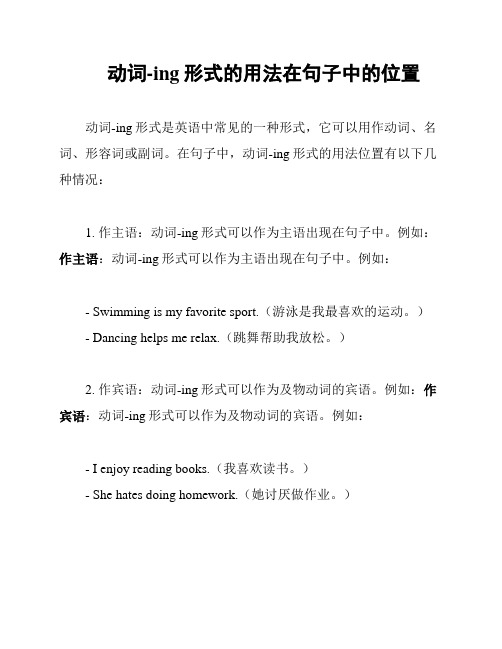
动词-ing形式的用法在句子中的位置动词-ing形式是英语中常见的一种形式,它可以用作动词、名词、形容词或副词。
在句子中,动词-ing形式的用法位置有以下几种情况:1. 作主语:动词-ing形式可以作为主语出现在句子中。
例如:作主语:动词-ing形式可以作为主语出现在句子中。
例如:- Swimming is my favorite sport.(游泳是我最喜欢的运动。
)- Dancing helps me relax.(跳舞帮助我放松。
)2. 作宾语:动词-ing形式可以作为及物动词的宾语。
例如:作宾语:动词-ing形式可以作为及物动词的宾语。
例如:- I enjoy reading books.(我喜欢读书。
)- She hates doing homework.(她讨厌做作业。
)3. 作表语:动词-ing形式可以作为表语出现在句子中,表示主语的状态或特征。
例如:作表语:动词-ing形式可以作为表语出现在句子中,表示主语的状态或特征。
例如:- His favorite activity is playing soccer.(他最喜欢的活动是踢足球。
)- The most interesting thing about him is his singing ability.(关于他最有趣的事情就是他的唱歌能力。
)4. 作定语:动词-ing形式可以作为定语修饰名词或代词。
例如:作定语:动词-ing形式可以作为定语修饰名词或代词。
例如:- The running water is very clear.(流动的水非常清澈。
)- She bought a loving gift for her mother.(她给妈妈买了一个充满爱意的礼物。
)5. 作状语:动词-ing形式可以作为状语修饰动词、形容词或副词,表示时间、原因、条件等。
例如:作状语:动词-ing形式可以作为状语修饰动词、形容词或副词,表示时间、原因、条件等。
ing的用法

She went on board the train leaving for Shanghai. =She went on board the train, which was leaving for Shanghai. 她乘坐了去上海的火车。 There are two roads before us, one leading to the beach, the other to the park. =There are two roads before us, one which leads to the beach, the other to the park. 在我们面前有两条路,一条通向沙滩,另 一条通向公园。
ing的用法
动词的-ing形式是动词的一种非谓语形式,由 动词原形加-ing构成,包括-ing分词和-ing动名 词。可以在句子中用作主语、表语、宾语、宾 语补语、状语和定语。
一、作主语
1.一般形式 Seeing is believing. 眼见为信。 Coming to Hangzhou by train tkes about 16 hours. 乘火车到杭州要16个小时。
Can you remember?
3.使役动词,如:set, keep, have, get, leave, catch等。如: Can you get my watch going again? 你能使我的表再走起来吗? This sets me thinking. 这使我思考。
动词ing形式做主语和宾语

Ing做主语和动词不定时 做主语有什么不同?
动名词常常表示泛指的动作, 而不定式通常指具体的动作 。
动词-ing形式作主语
1. 动词-ing形式作主语表示抽象的或泛指的 动作, 谓语动词用单数。如: Reading aloud is very important for us to learn a foreign language. To read aloud will help you improve your English.
6. ____ the homework made his father lose his temper.
A. The boy’s not having done B. The boy not having done C. The boy’s having not done D. The boy having not done
2. 既可接动名词又可接不定式作宾语的动词, 常见的有: begin, start, continue, like, love, prefer, by, mean, forget,remember, hate等。 A. like, love, hate, prefer 用-ing或不定式意义上没有什么不同, 动名词表示泛指的动作, 不定式表示具体的一次性动作。 B. 在begin/start, continue之后, 用动名词和 不定式, 意义无甚区别. C. 在动词forget, remember, regret之后意义不同
等; 形容词有: dangerous, worthwhile, useless等。 如:
It’s no use sweeping tears. It was a waste of time doing such a thing. Exer. P13
动词 ing的用法
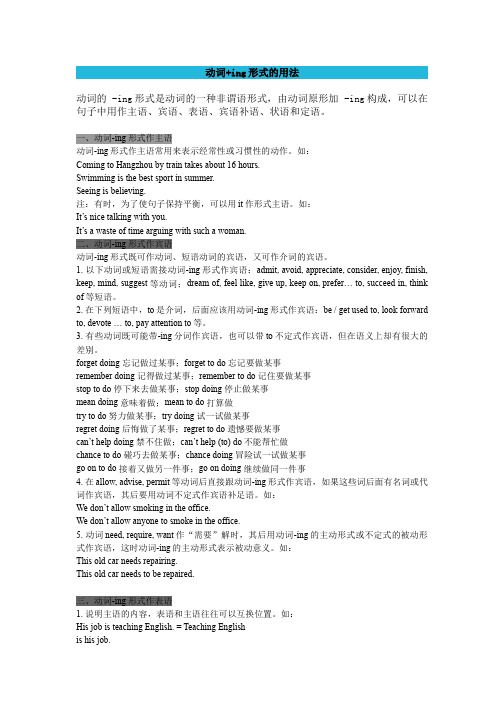
动词+ing形式的用法动词的 -ing形式是动词的一种非谓语形式,由动词原形加 -ing构成,可以在句子中用作主语、宾语、表语、宾语补语、状语和定语。
一、动词-ing形式作主语动词-ing形式作主语常用来表示经常性或习惯性的动作。
如:Coming to Hangzhou by train takes about 16 hours.Swimming is the best sport in summer.Seeing is believing.注:有时,为了使句子保持平衡,可以用it作形式主语。
如:It’s nice talking with you.It’s a waste of time arguing with such a woman.二、动词-ing形式作宾语动词-ing形式既可作动词、短语动词的宾语,又可作介词的宾语。
1. 以下动词或短语需接动词-ing形式作宾语:admit, avoid, appreciate, consider, enjoy, finish, keep, mind, suggest等动词;dream of, feel like, give up, keep on, prefer… to, succeed in, think of等短语。
2. 在下列短语中,to是介词,后面应该用动词-ing形式作宾语:be / get used to, look forward to, devote … to, pay attention to等。
3. 有些动词既可能带-ing分词作宾语,也可以带to不定式作宾语,但在语义上却有很大的差别。
forget doing 忘记做过某事;forget to do 忘记要做某事remember doing 记得做过某事;remember to do 记住要做某事stop to do 停下来去做某事;stop doing 停止做某事mean doing 意味着做;mean to do 打算做try to do 努力做某事;try doing 试一试做某事regret doing 后悔做了某事;regret to do 遗憾要做某事can’t help doing 禁不住做;can’t help (to) do不能帮忙做chance to do 碰巧去做某事;chance doing 冒险试一试做某事go on to do 接着又做另一件事;go on doing 继续做同一件事4. 在allow, advise, permit等动词后直接跟动词-ing形式作宾语,如果这些词后面有名词或代词作宾语,其后要用动词不定式作宾语补足语。
动词ing形式的用法归纳

动词ing形式的用法归纳
动词ing形式是一种非谓语动词形式,它可以充当多种句子成分,如主语、宾语、定语、状语等。
以下是动词ing形式的主要用法归纳:
1.动词ing形式作主语:动词ing形式可以作为句子的主语,表示一种概念、
习惯或经验。
常见句型有“It be no use doing something”(做某事没有用)等。
2.动词ing形式作宾语:动词ing形式可以用作动词、介词或短语动词的宾语。
例如,在动词finish、enjoy、mind、miss等后接动词ing形式作宾语。
3.动词ing形式作定语:动词ing形式可以用来表示被修饰的词的某种用途,
也可以用来修饰名词。
例如,“a sleeping child”(一个睡觉的孩子)和“a sleeping bag”(一个睡袋)。
4.动词ing形式作状语:动词ing形式可以用作状语,表示行为或状态的特征
或方式。
例如,“He came running to the house”(他跑着来到房子前)。
5.动词ing形式作宾语补足语:在感官动词后,如see、hear、feel、notice
等,可以用动词ing形式作为宾语补足语,表示动作正在进行。
1/ 1。
动词-ing形式作主语和宾语

动词-ing形式作主语和宾语一、动词-ing形式作主语1、动词-ing形式做主语时,常表示一般或抽象的经常性、习惯性的动作,谓语动词用单数。
Eg:Swimming is my favourite sport..Saying is easier than doing.2、在It is no use/no good/fun/a waste of time/useless等句型中,用it作形式主语放在句首,真正的主语用动词-ing形式放在句末。
Eg:It’s no use waiting for him any longer.It’s a waste of time arguing about it..二、动词-ing形式作宾语1、有些动词后面要跟动名词作宾语。
可用以下口诀记住:避免错过少延期(aviod,miss,postpone)建议完成多练习(advise,finish,practise)喜欢想象禁不住(enjoy,imagine,can’t help)承认否定与嫉妒(admit,deny,envy)逃避冒险莫原谅(escape,risk,excuse)忍受保存不介意(stand,keep,mind)Eg:Will you admie having broken the window?Would you mind turning down your radio a little?The squirrel was luckly that it just missed being caught.注意:某些以to结尾的动词短语也必须接动词-ing形式做宾语,常见的有:Devote oneself to(投入……),get down to(着手干……),lead to(通向,导致),object to(反对),pay attention to(注意),look forward to(盼望),be used to(习惯于),stick to(坚持)等。
动词-ing形式 (现在分词形式)做各种句子成分 高中英语

动词-ing形式由动词原形+ing构成,一方面具有 动词的性质,另一方面也相当于一个名词、形 容词或副词。动词-ing形式能在句中作主语、宾 语、表语、定语、宾语补足主语
Collecting information is very important to businessmen. Learning a foreign language is very useful to me. Seeing is believing. Travelling abroad can be very exciting.
动词-ing形式拔高
一般式
主动形式 doing
被动形式 being done
完成式 having done having been done 其否定形式是在doing前加not
意义
表示的动作和谓语动词所表示 的动作同时发生
表示的动作发生在谓语动词所 表示的动作之前
While shopping, people sometimes can’t help being persuaded into buying something they don’t really need.
五、v-ing形式做宾补
We heard her singing in her room. You can see them performing every night this week at the new theatre. We watch the childing diving into the water from the diving board. Listen to the birds singing.
There is/was no use/ point (in ) doing You don’t take advice so there is no point in asking for it.
- 1、下载文档前请自行甄别文档内容的完整性,平台不提供额外的编辑、内容补充、找答案等附加服务。
- 2、"仅部分预览"的文档,不可在线预览部分如存在完整性等问题,可反馈申请退款(可完整预览的文档不适用该条件!)。
- 3、如文档侵犯您的权益,请联系客服反馈,我们会尽快为您处理(人工客服工作时间:9:00-18:30)。
B4Unit 2 Grammar
The -ing form as the Subject and Object 动词的 ing 形式如何构成?有哪些规则?一.找出句子中有动词 -ing 做主语和宾语 1. Since then, finding ways to grow more rice has been his life goal.
2. As a young man, he saw the great need for increasing the rice output.
3 .Dr Yuan searched for a way to increase rice harvests without expanding the area of the fields.
4. He enjoys listening to violin music, playing mah-jong, swimming and reading.
5. Spending money on himself or leading a comfortable life also means very little to him.
6. Just dreaming for things, however, costs nothing.
7. Dr Yuan awoke from his dream with the hope of producing a kind of rice that could feed more people.
二. .练习与归纳
1. Fill in the blank (tips from the pictures)
(1) ______ . ______ is my favourite sport.(play football)
(2) ____________________ .My sister enjoys alone on the
seashore. (stand)
(3) ____________________ .The cartoon is . (amuse)
(4) .Chi na is a _________ coun try. (develop)
(5) .We heard Tommy _________ i n his room.(s ing)
(6) She sat at the desk _____ a n ewspaper.(read)
2. 动词-ing形式时态和语态:动词-ing形式的构成:是在动词末加 -ing 形式构成。
否定形式:not + -ing 构成.动词-ing形式不能单独作谓语,没人称和数的变化,但可以有自己的宾语和状语,还有时态和语态的变化。
3. 在本单元讲解动词-ing形式在句中作主语和宾语的用法。
即动名词作主语和宾语.
Part1.动词-ing形式作主语
1. 直接置于句首
(1 )Playing t ricks on others is something we should never do.
(2) Lear ning new words is very importa nt for me.
⑶ Talki ng is easier than doi ng. 说比做容易。
2. 用形式主语it,把真正的主语-ing形式移置句尾。
但这种句子形式有一定的限制,作表语的只能是某些形容词或少数名词。
(1) It is useless tryi ng to argue with Shylock.
(2) It ' s worthaking the effort.这事值得努力去做。
(3)It is pleasant working with you. 常用 -ing 形式作主语的句型
It + be + a waste of time doi ng ..... 做是浪费时间的
It is/was no good/use doi ng 做... 是没益 / 用处的
It is/was hardly/scarcely worth doing 做... 不值得
It is/was worth/worthwhile doi ng 做.... 是值得的
3. 在 there be no doing 结构中作主语。
这种结构的意思相当于“It
is impossible to do …”。
(1) There is no ______ (hide)of evil but not to do it. 若要人不知,
除非己莫为。
(2) Here is no _______ (joke)about such matter. 这种事开不得玩
笑。
(3) There was no _____ (know)when he would leave. 无法知道
他什么时候离开。
There is no sense in doing 做……没有道理
Part2. 动词 -ing 形式作宾语
1. 只能后接动词 -ing 形式作宾语的动词或短语 , 常见的有 avoid , consider ,enjoy ,
2. 既可接动词-ing又可接不定式作宾语的动词,常见的有:begin , start,continue ,like,love,prefer ,by,mean,forget ,remember , hate 等。
A. 在 like , love , hate , prefer 等动词之后,用 -ing 或不定式意义上没有什么不同,只是侧重点有些不同,动词 -ing 形式表示泛指的动作,不定式表示具体的一次性动作。
B. 在begin/start , continue 之后,用动词-ing和不定式,意义无甚区别,尤其是当主语是人的时候。
C. 在动词 forget , remember , regret 之后,用动词 -ing 与不定式意义不同。
动词 -ing 表示动作先于谓语发生,不定式表示后于谓语动作。
如:
I remember posting the letter. 我记得我已把信寄了。
I ' ll remember to post the letter. 我会记着去寄信的。
I shall never forget seeing the famous writer. 我永远不会忘记见
到过那位著名作家。
Don ' t forget to write to your mother. 不要忘了给你母亲写信。
D. 在try ,mean之后,意义各不相同,如try to do (设法),try doing
(试试),
mean to do (打算,有意要做), mean doing (意思是,意味着)。
E. go on doing 和 go on to do: go on doing 继续做一直在做的事;
go on to do 接着做另一件事。
女口: Please go on doing the same exercise. 请接着做同一个练习。
Please go on to do the other exercise. 请做另外一个练习。
F. stop doing 与 stop to do: stop doing 停止做 ;stop to do 停下正在干的事去干另一件事。
如: We stopped talking. 我们停止了交谈。
/We stopped to talk.
我们停下来去谈话。
3. 作介词宾语下列短语中的 to 都是介词,所以后面跟名词或 -ing 形式:devote to , object to , pay attention to , get down to , lead to , look forward to , stick to , be used to 等。
Step3 Practice
1. ______ p rovides us with essential nutrients (营养 ), while
__________ provides us with oxygen. (eat, breath)
2. Have you forgotten _________ $1000 from me last month?
Will you please remember ______________ it tomorrow? (borrow,
bring)
3. My brother keeps _______ me with my work. (help)
4. We should often practise __________ English with each other.
Speaking
5. Though it sounds a bit too dear ( 昂贵),it is worth _____ .
(buy)
6. He devoted his life to _____ the atomic theory. (study)
8. We are both looking forward to _________ ( 休假 )
next week. (go on vocation)
9 . Once the heart stops ______ , death follows at once. (beat) 1 0 . We are now busy ________ f or the exam in ati on. (prepare)。
